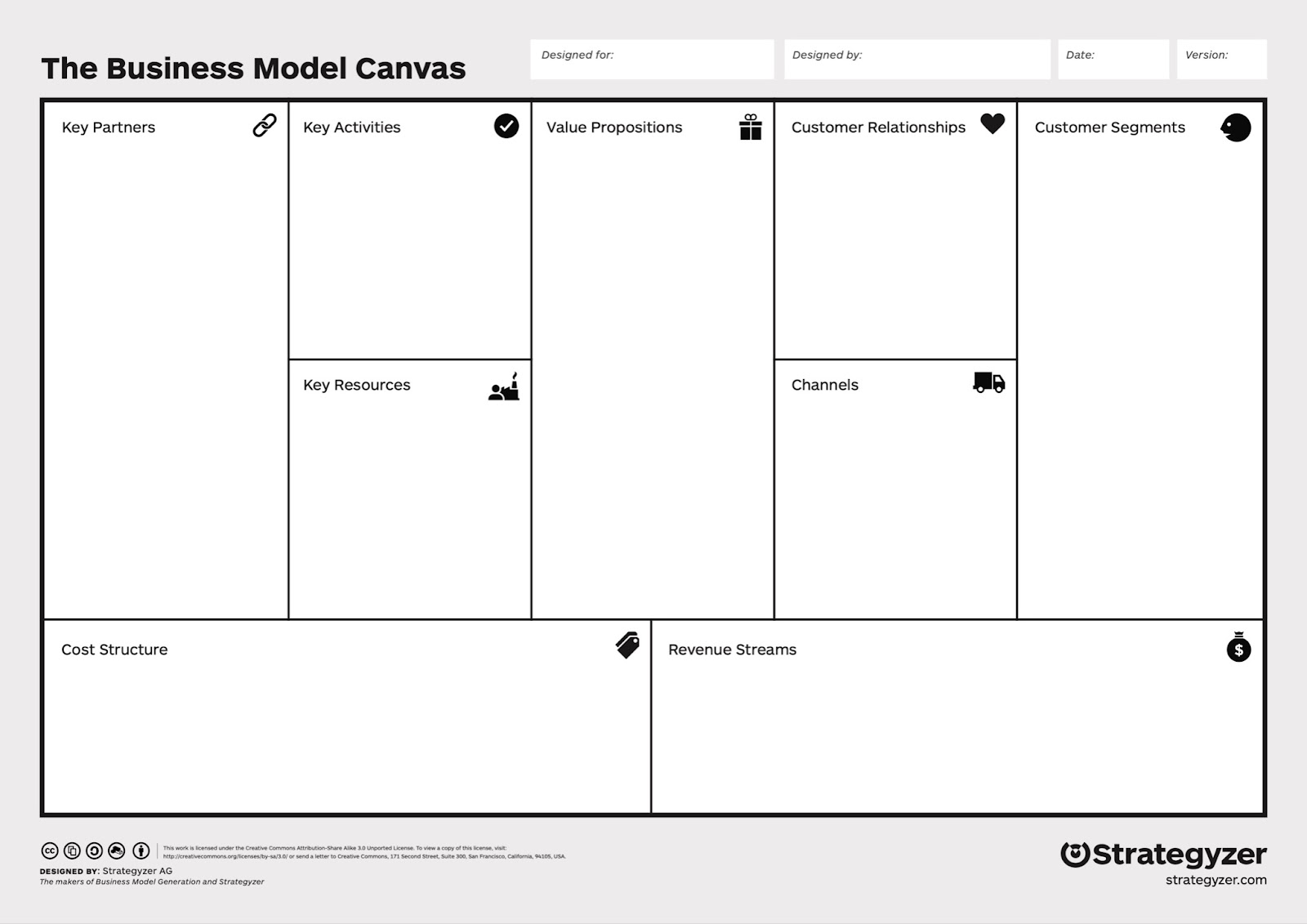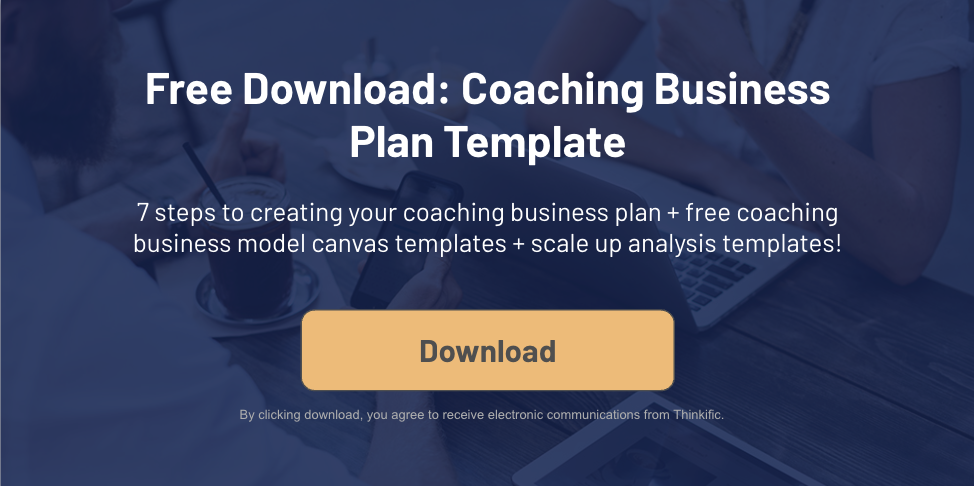Not all coaching businesses are the same. The profession spans many different types of coaching (e.g., health, fitness, business, life) and engagement styles (e.g., one-on-one, conferences, courses, books).
That’s why a one-size-fits-all business coaching model doesn’t exist. Your business model should reflect your unique value proposition, the way you make money, and how you deliver your coaching services.
Thankfully, this doesn’t mean you have to invent an entirely new business model from scratch to succeed. Using free and tried resources and templates for entrepreneurs (like the Business Model Canvas we will be discussing in this article) will help you skip the groundwork and align your business model with a widely recognized framework.
Read this guide to become an expert in creating custom coaching business model canvases and building the right entrepreneurial foundation for your practice.
What is a Business Model Canvas?
The Business Model Canvas is a popular framework based on a simple template that outlines all the key aspects of a business. It helps entrepreneurs see their business from a high-level perspective and spot opportunities and weaknesses early on, in the planning stage.
The concept of the Business Model Canvas was developed in 2005 by Alexander Osterwalder (and a team of 470 co-creators). He described the framework at length in his book Business Model Generation:
“A business model describes the rationale of how an organization creates, delivers and captures value.”
— Alexander Osterwalder, Business Model Generation
Osterwalder’s framework includes nine building blocks grouped into four sections:
- Infrastructure (key activities, key resources, key partners)
- Offering (value proposition)
- Customers (customer segments, channels, customer relationships)
- Finances (cost structure, revenue streams)

Key activities are what the company has to do to deliver on its value propositions in the most optimal way possible. This block should lay out processes and automation, and organize your team’s work.
Key resources sums up the elements needed to create customer value. These are your assets: your team, revenue, know-how, technology, gear, etc.
Key partners outlines who will help you do your work — because not all of it has to be done in-house. As a coach, you can be part of a professional network or engage a designer to work on your marketing collateral.
Value propositions sums up your offerings and how they relate to your customers’ needs. This element should set you apart from your competition. Executive coaches might focus risk reduction, fitness coaches might offer proprietary training programs, and so on. You can distinguish between quantitative (e.g. money) and qualitative (e.g. feeling) value propositions.
Customer segments identifies your target audience. You can have more than one target audience documented as brand personas, with varying needs and other characteristics. On a macro level, your audience can align with the mass market, a niche market, be segmented, diversified or multi-sided (i.e. be a platform).
Channels describes how you intend to reach your customers with your value proposition. It can be a retail store, an e-commerce solution, a social media profile, or a combination of different channels.
Customer relationships sums up how you’ll get new customers, how you’ll retain them, and how you’ll increase their value over time.
Cost structure describes what the business has to spend money on to deliver its value propositions. This block should include fixed costs like rent or salaries as well as variable costs like credit card processing payments. As your business expands, costs per unit of value produced could go down (e.g. through scaling and optimizing your processes) or up (e.g. by branching out into a more complex set of services).
Revenue streams predicts or describes how a company makes money. As a coach, you can sell online courses, subscriptions, eBooks, etc. Your face-to-face coaching sessions are also a revenue stream.
Since revenue streams are so central to any business and are the first thing people think about when talking about business plans, we’ll go into more detail about potential revenue streams (both primary and supplemental) available to coaching professionals.
Primary business models for coaches
There are lots of ways to make money in the coaching business. Below, we go over the most popular primary coaching revenue streams.
Coaching
Most coaches build their businesses around — surprise — coaching. It’s simply the easiest way to start bringing in revenue.
This revenue stream includes different subcategories:
One-on-one coaching doesn’t require complex curricula to get up and running. It’s more about listening to your client’s needs and using your expertise (in any particular field) to help them.
The good thing about coaching is that you can start at any time — there’s no large upfront investment involved. And, clients tend to stick to great coaches long-term, so you can expect to grow via word-of-mouth marketing for free over time.
The downside to one-on-one coaching is that it offers limited opportunities to grow and scale your business. Unless you start an agency and hire other coaches, you will only be able to make money when you’re doing hands-on work (even if you primarily offer online coaching).
Group coaching is an interesting way to scale your coaching practice. It allows you to multiply your hourly rate by the number of clients in your group.
However, this type of coaching requires much more preparation and expertise. It can also limit your scope of work. For example, workplace coaching for teams and executives is a niche made for group coaching. Life coaching that focuses on individual needs, fears, and goals, on the other hand, is a better fit for one-on-one sessions.
Both one-on-one or group coaching can be delivered either in-person or virtually. The latter can significantly expand your potential customer base, wherever you are.
Workshops
Workshops can also be the focus of a coaching business model. Unlike group coaching, uniquely tailored to every group, workshops are standardized learning environments. You only have to come up with the framework once, and then sell it over for years. You can also charge per seat and sign up more profitable corporate clients.
A workshop is a predefined offering that can be purchased either by an individual or a company. But they’re not a self-serve product — workshops are collaborative, and require your active participation every time. For example, branding coaches might sell a vision-setting workshop, where they guide a team of senior executives towards defining their company’s long-term plans.
Workshops are more difficult to sell than “regular” coaching sessions. They’re a larger expense, and are usually billed to a company. Decision-makers may not want to commit to your workshop unless you have an established reputation.
Speaking engagements
If you’re looking to get less personally engaged with individuals or groups as a coach, you might find speaking engagements to be an attractive revenue stream.
Speaking engagements are more available to people with high name recognition. In fact, many coaches write books just so they can use them as leverage to get speaking gigs.
But presenting at conferences or special events can be very profitable. Speaking for just 30 minutes can yield tens of thousands of dollars. It’s also a good way to promote your other work, like coaching, workshops, books or anything else.
Supplemental revenue streams for coaches
One of the great superpowers of coaching is that you can combine all kinds of revenue streams to make your financial results more predictable and scalable.
Here are a few money-making ideas you should explore on top of coaching, running workshops and speaking at industry events.
Online courses
One of the most scalable sources of income available to almost any coach is online courses.
An online course can be created for virtually any purpose, and you only have to put time into setting it up once. It can cost as much or as little as you want and continue to generate revenue for years to come.
All this makes online courses one of the most effective business coaching models, and one that yields a particularly high return on investment (ROI).
Anyone can set up an online course. Even if you’re not an expert or don’t consider yourself tech-savvy, getting started is easy. The only significant cost to you is the time you put up front.
When designing online courses, a user-friendly e-learning platform is essential. Thinkific is a course creation platform that can be used without any coding or design skills. You can create beautiful courses using hundreds of templates and an intuitive drag-and-drop interface.
You can create your first course on Thinkific in a day and start selling it right away. What are you waiting for?
Use Thinkific to make a bigger impact on your clients and earn more revenue — without trading your time for money.

Coaching membership sites
We mentioned above that planning how you can increase your revenue per client should be an important element of your business model.
If online courses are one-off purchases, how can you continue monetizing the same customers?
The answer is coaching membership sites. Unlike courses, these are continuous learning platforms. While you can integrate online courses into your membership website, its main value is community.
Members pay for access on a recurring basis and can then learn, ask questions, talk to each other and feel like they belong to something bigger than themselves.
Communities and membership sites are very powerful because they attract committed audiences that you could later monetize in other ways as well.
Start building your community early on. Create a Facebook Group, collect emails for your newsletter, or encourage your online course clients to stay in touch.
Advertising
Lots of successful coaches are also content-creators. Having a blog, an Instagram account or a YouTube channel plays a few important roles.
Making valuable content available for free can be a great source of leads for your primary revenue streams (e.g. coaching or speaking). But it can also be a revenue stream of its own:
- You can sell advertising on your blog through AdSense.
- On Instagram, you can partner with brands to create sponsored posts.
- On YouTube, you can either rely on native ads or create sponsored content with brands.
While it’s difficult to make advertising your primary source of revenue without a significant audience (in the hundreds of thousands), it can be an interesting experiment in diversification.
Affiliate sales
You don’t need to only sell your own products. In fact, if you help sell someone else’s products or services, you can get a cut of the sales. This is called affiliate sales and is a revenue stream well known to online content creators.
Most major e-commerce websites and software vendors have affiliate programs. For example, if you mention a book (or any product) from Amazon on your blog, you can get some revenue from every sale done through your personal link.
Books
Books are by far the most important carriers of ideas. There’s nothing just as powerful for a coach as having an original idea and writing a book around it.
Not only can books create a significant revenue stream for you, but they are also the best type of advertisement you can ask for. You sell books as a coaching package with your workshops and online courses. You can also leverage books to get speaking engagements and high-level coaching clients.
If writing a book sounds daunting, don’t worry. The key is starting small, by keeping notes around the ideas you like and coming up with your own solutions. As your practice grows, your expanded knowledge and experience will practically write the book for you.
Auxiliary tools and software
It’s possible to take productization to another level and turn your ideas into software or other tools to help your clients (e.g. card decks based on your workshops or simple Excel-based calculators for keeping track of time savings).
That’s the path that Strategyzer (the company behind the Business Model Generation book) has chosen. They offer an app that puts exercises in the book into an interactive online environment.
Building software is hard. But if you have a great idea and your audience is asking for it, you should consider looking into it.
Turn your business model into a reality
Now that you understand all the building blocks of the coaching Business Model Canvas, it’s time to build your own.
Use the coaching business model template above to think through your value proposition, processes, and revenue streams. Then build your coaching program!
Kickstart your coaching career by building and selling your online course. Try Thinkific for free today, and see how easy it is to get started. No tech skills required.







